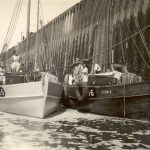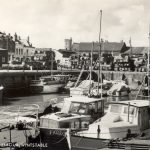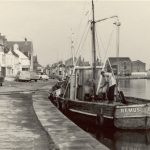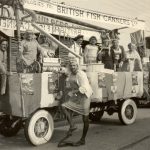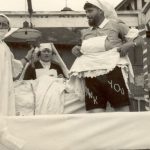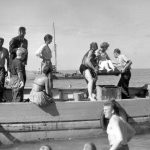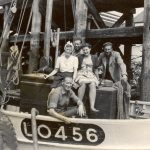Fishing Years
The Leggatt brothers, caught at sea in bad weather during the winter of 1948, were forced to run into Whitstable Harbour for shelter, impressed with the town, its harbour and facilities, brother Alf and George from Canvey Island and owners of the trawlers Sea Hawk Queen and Leona II, decided there and then to make Whitstable their future home and fishing port. Moving posed no problem for Alf, aged thirty-three. He came across the estuary the following year, bring his family, furniture and possessions aboard Sea Hawk Queen to their new home in Island Wall. George, aged thirty-one, who was to live at Westgate Terrace, followed later.
The Leggatt Brothers start Pair Trawling
Some extracts of text taken from Bygone Kent article by Roger Turner
There was little fishing activity when they first arrived on the scene, it was almost as if Whitstable Harbour, following the war years, had been forgotten. But all this was to change. For the Leggatt brothers were soon to bring a new lease of life to the port which once thrived on its oyster industry and on trade brought by ships during the days of sail – by fishing sprats in a big way. Spratting was revolutionised in the Thames Estuary when the introduced a new method of catching them: pair trawling. Two boats towing one net with a specially adapted mid-water trawl.
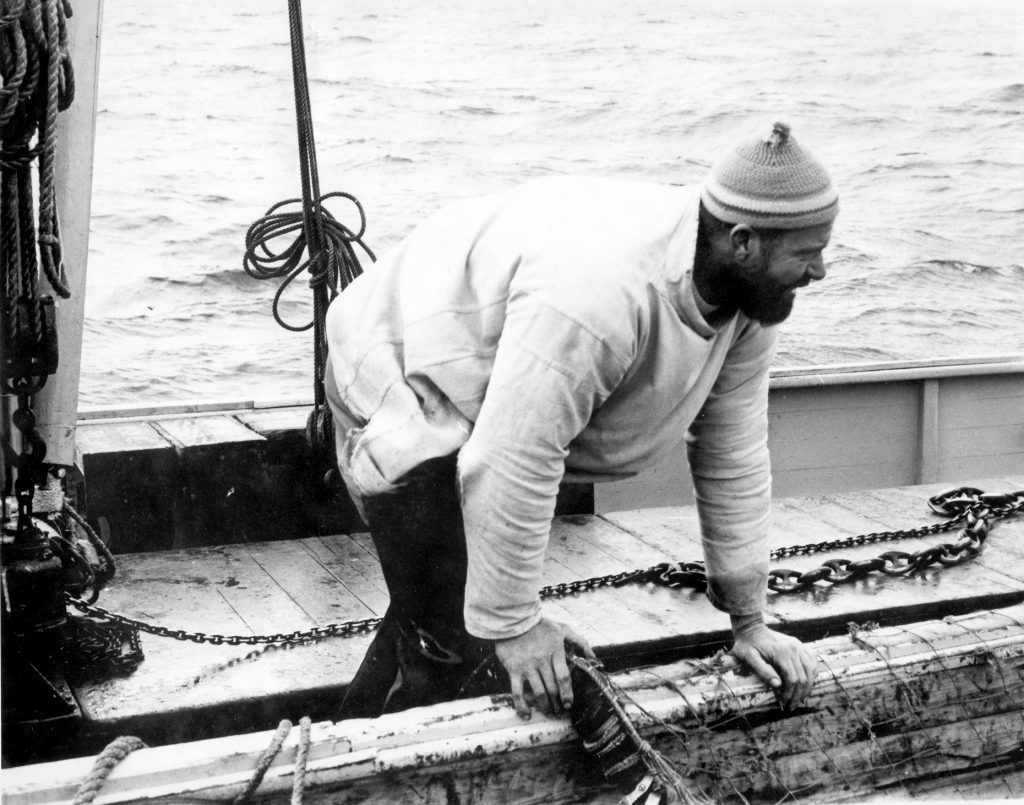
They were the first inshore fisherman in the British Isles to use an echo sounder to detect shoals, and within six years were operating nine trawlers, four of which were built at the local yard at Whitstable.
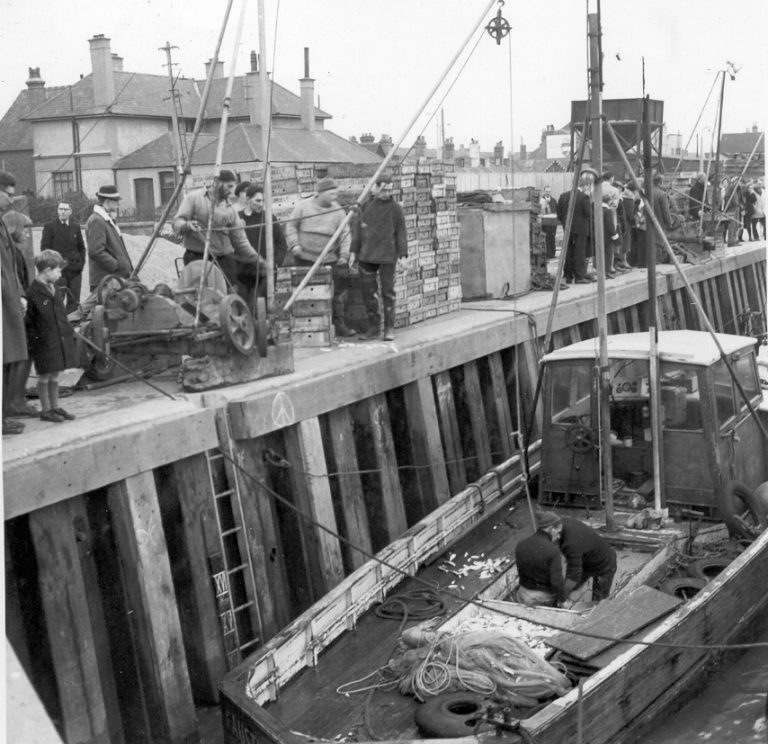
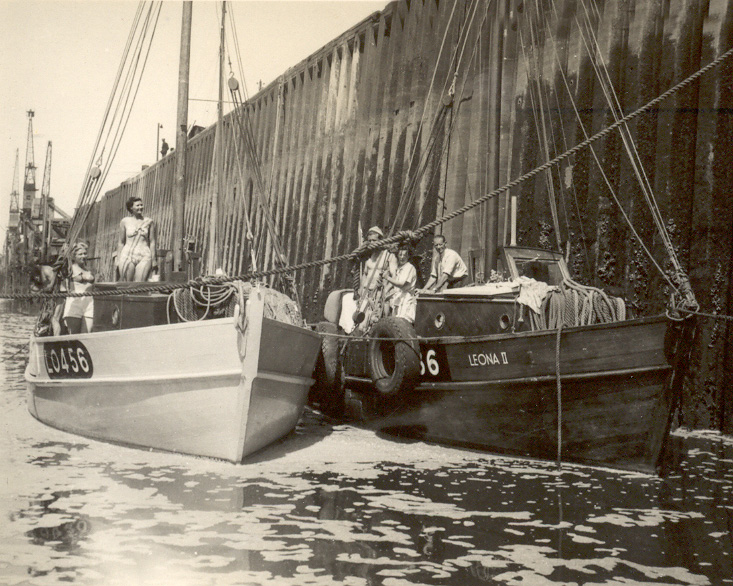

Alf admitted he often watched spratters at work. It was a long and tedious job with poor results, and he wondered whether there wasn’t a more efficient way of catching them. They used the stow net, a passive method of fishing in which a boat was anchored and a shoal of fish swam into the net. Alf has experience with echo-sounders during the war while serving on MGB’s and found that it was possible to see fish with them. In the summer of 1950 they carried out experiments in the clearer waters of the Devon and Cornish coasts by pair-trawling with a mid-water trawl, based on the design by Norwegian named Larsen. As sprats shoaled anywhere between the sea bed and the surface the net had to be set to fish accurately as various depths. Even the services of a diver were engaged to check that everything was going to plan underwater. The price of a Kelvin Hughes echo-sounder, at £534, was inhibitive, Alf recalls it was almost as much as his home and half the cost of a brand new trawler, but he was convinced it would pay off. Not so George, who thought it was “madness”! Bit on their very first haul in the Thames Estuary with Sea Hawk Queen and Leona II after locating a shoal with the sounder – they had five tons, the catch worth £240 and more than some of the local boats landed during an entire season, came from the Swin on the edge of the Barrow Sand. The sounder remained a secret for some time from the others. Alf admits “we kept and oilskin over it in the wheelhouse so people thought it was a radio.”
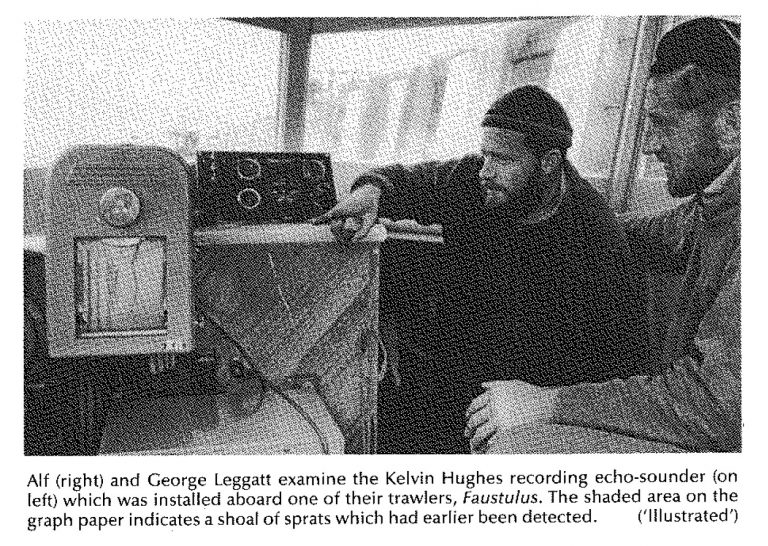
Photo of Echo Sounder
When British Rail-owned harbour, in a dilapidated state following severe damage after the 1953 Flood, was threatened with closure, Alf and George Leggatt led a campaign to save it – and Whitstable Council stepped in to buy and restore it. Fishery Officers who represented and advised Third World countries, including Peru, India and Nigeria accompanied the Leggatts as sea to study and learn methods. Experiments, outside the sprat season, were conducted off Cornwall and the Scilly Isles for pilchards and the North East coast for herring. The Ministry of Agriculture and Fisheries followed their activities with interest, and the highlight of Alf’s career came in 1956 when he was awarded the MBE for his services to the fishing industry. Three years earlier he had also received the Coronation Medal.
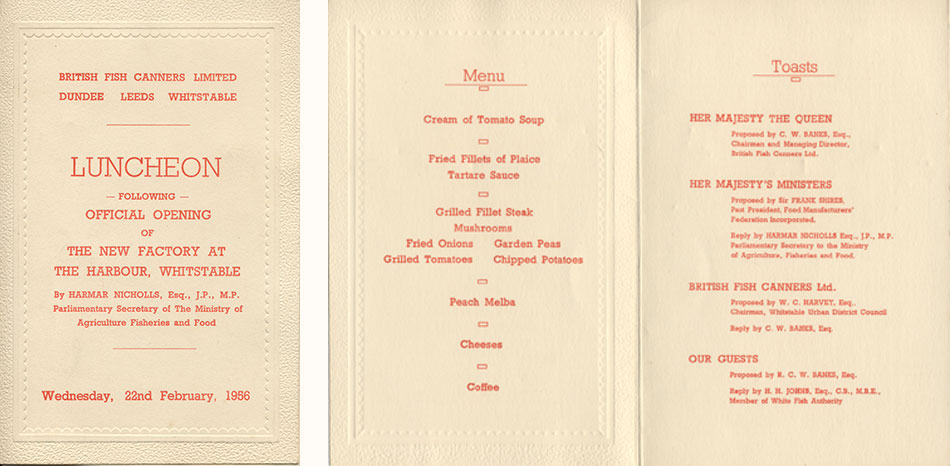
Alf negotiated for the British Fish Canners Ltd to open a factory on Whitstable Harbour
With their fleet averaging 100 tons weekly during the season, between November and March, Alf negotiated for the fish canning factory which, employing 140 women, was opened near the harbour in 1956. Here, one-and-a-half million sprats -small silver fish resembling herring (though unrelated) and with excellent eating qualities – were canned daily. The new factory was built on the harbour and the two northern factories employing a further 350, Alf had a full-time job keeping them all supplied. He never let them down, but it often meant working through gale-force conditions. Regular supplies were taken during the season by wholesalers HG and FM Newman and Sons of Tankerton, near Whitstable.
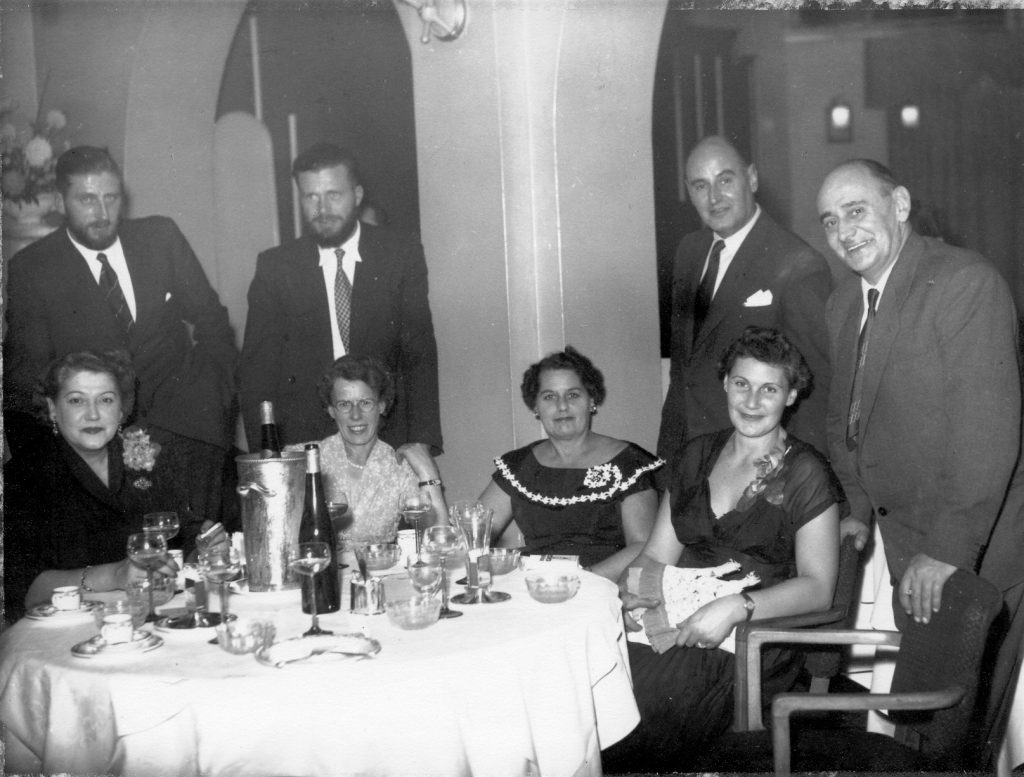
Whitstable was taking on a new dimension in the 1950s as a major East Coast sprat port. Fishermen Alf and George Leggatt’s investment in a Kelvin Hughes recording echo-sounder turned out to be an immediate success in helping them trace shoals of sprats in the Thames Estuary. Until they were geared up to off-load their catches at Whitstable their sprats, selling for 24p per hundredweight, were landed for the British Fish Canners at Southend, where they were transported daily to factories at Leeds and Dundee. When canned they were sold as brisling and slid. During the course of one week in November 1954, the firm bought over £800 worth – 1,337 bushels at 12 shillings per bushel – distributing them, among other areas, Billingsgate, Grimsby, Poole and Brighton. (a bushel measures roughly four stone.)
Following their initial successes the Leggatts ordered three new 39ft trawlers in 1954 from the Whitstable yard of RJ Perkins. These were Romulus (F6) and Remus (F7) at £3500 each and powered by 60hp Thornycrofts, and Faustulus (F21), £5,000 with a four cylinder Gardner engine, all carvel constructed of pitch-pine and oak. Others to follow wer Harvesters I (F121) and Harvesters II (F122), 36ft ex-Navy harbour service launches at £500 each, which were coverted into fishing craft and fitted with Bolinder diesels, and TTFN (F20), a 52ft ex Navy vessel. The Leggatts also bought the 36ft Cortina (F27), built by Perkins for Whitstable fisherman Oliver Wiseman who emigrated to Australia.
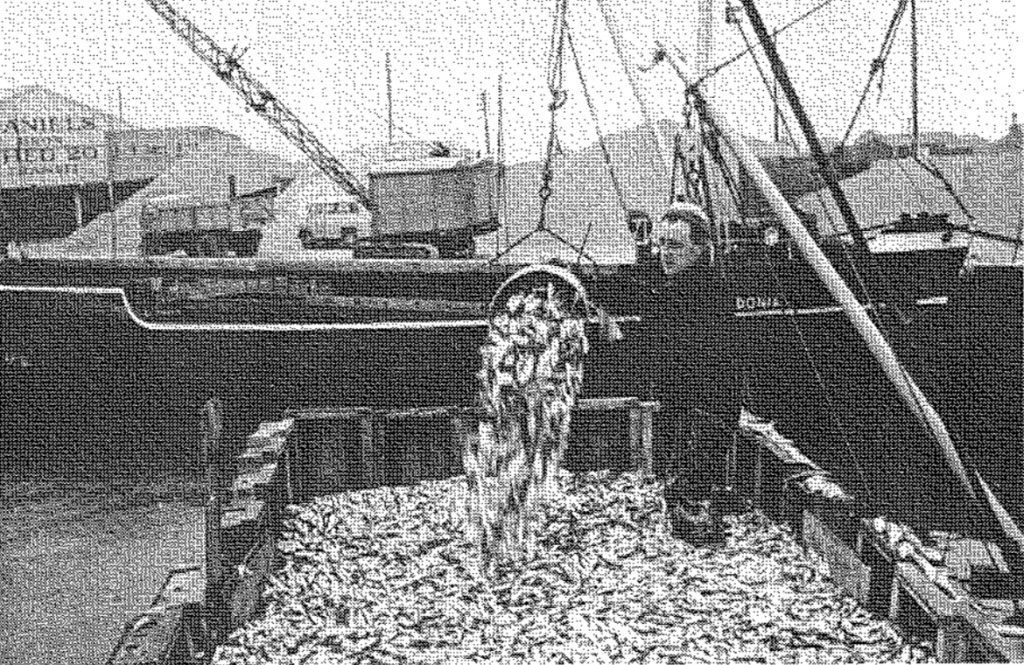
Conventional trawling in winter was hazardous during bad weather, but the spatters had the added burden of being heavily loaded, with their decks awash when the holds were full. When the Cortina began to sink after being struck by heavy seas with six tons aboard off Skegness in 1968, Alf’s son Barry jumped to safety aboard the pair partner Leona II which was alongside. Getting a large catch aboard was no mean feat and had to be carried out in stages. Originally several hundredweight at a time were lifted aboard manually but with the introduction of a derrick and block and tackle half ton could be winched aboard. Uploading problems were solved when Alf rigged up derricks and car back axles powered by electric motor, to lift the sprats, which were shovelled into galvanised dustbins, up to the quay. The Whitstable cannery handled much of the fleets weekly average catch of 100 tons which landed during the winter, with two-thirds going into cold storage to keep the factory in operation during the close season. A record landing by pair team was eleven tons in seven minutes, and seventeen lorries were needed to dispatch the fleets greatest catch in one day of around 90 tons.
A mile of sprats spilt down Whitstable High Street
Probably the best remembered incident involving Whitstable and the sprat fishermen took place in December 1963, when a lorry lost its twelve-ton load of sprats almost a mile of the main street. Cars slid and skidded, cyclists were upended and pedestrians struggled to keep their feet as the silvery stream cascaded from the back of the lorry along Harbour Street, High Street and to the railway bridge in Oxford Street where the driver -wondering why motorists were “beeping” him from behind – eventually pulled up.
White-weeding whilst sprats were out of season
The “Kent Messenger” was promoted to send a reported down to Whitstable Harbour to solve the mystery: why the Leggatts, were spending 12 to 15 hours daily at sea when the weather was fine, and returning with no fish but tons of weed. The new” Whitstable industry” as it was termed, turned out to be white-weeding, when five foot metal rakes were dragged along the sea bed to collect weed. Washed to remove sand, wrung out on board with a mangle and bundled up in sacks, it was sold to a Whitstable buyer. Once cured with glycerine and dyed, white wee would last indefinitely and was used for decorative purposes find a ready export market.
The rake used were larger versions of the original oyster dredges. Ald had them made by the local blacksmith but the teeth were cut out of half inch and four inch plate by a profile cutter at Wingham Engineering Company. The Leggatts method of white-weeding, using power winches and wire rope, proved effective. Most small boats used ordinary ropes which had a far greater lift, so making it much harder to keep the rakes, which had to be towed against the tide, on the bottom.
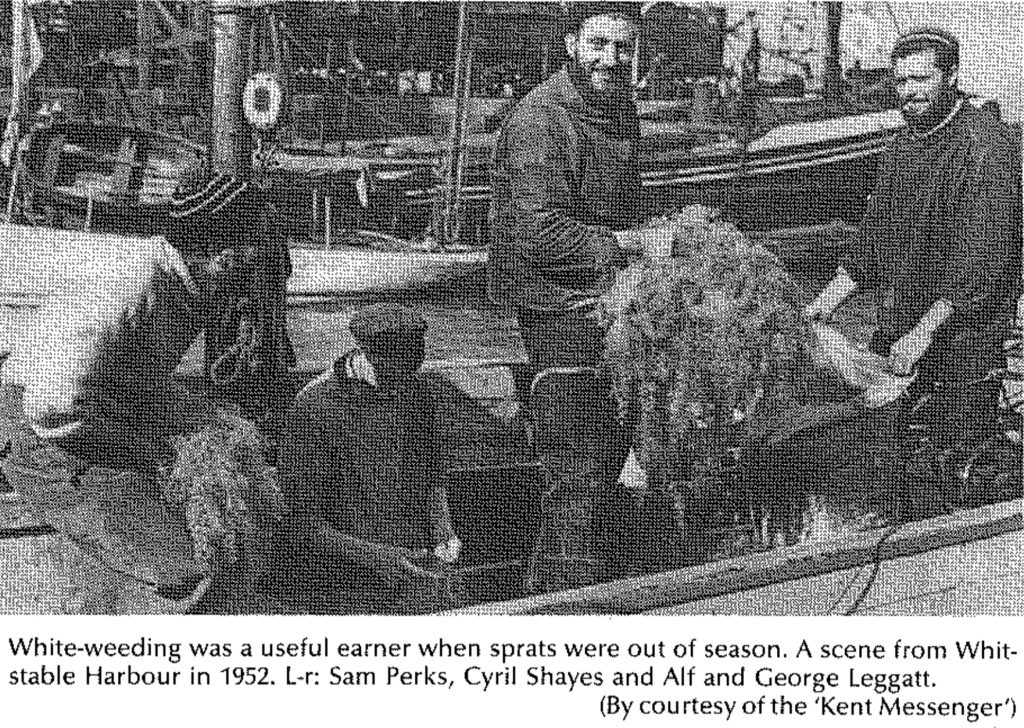
Alf receives MBE at Buckinham Palace 1956
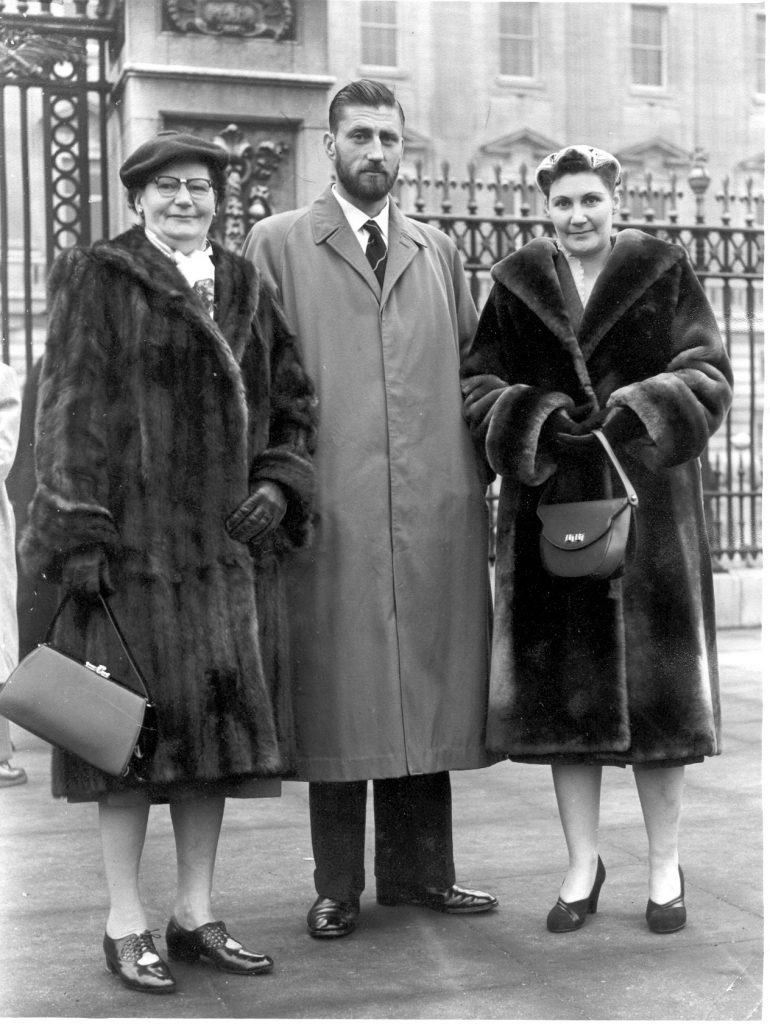
For services to the fishing Industry, Alf receives the MBE from the Queen at Buckingham Palace. His work revolutionised the methods of catching fish. He is joined by his wife Joan and his Mother Rose Behar.
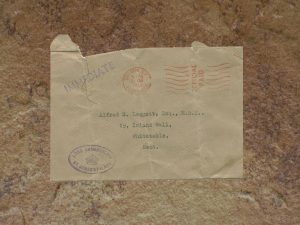
Letter from St James Palace inviting Alf and guests to come up to Buckingham Palace to collect his Medal. Alf had ealier been awarded the Coronation Medal in 1953 by Queen Elizabeth II. Again, this was for his services to the fishing industry.
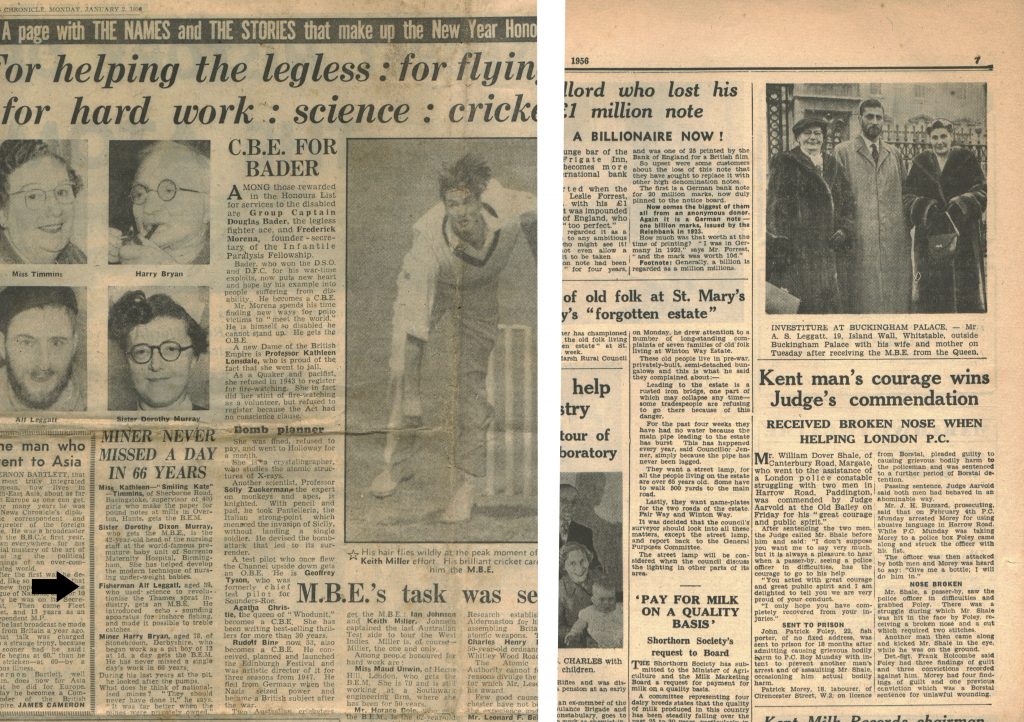
In search of fish, the Leggatt Brothers experimented taking several boats to Lowestoft and the Wash
Alf however, would be the first to admit that fishing never has, and never will, run the true course. One season in 1957 was so bad that “it nearly floored us” and two of their boats were sold. Catches were 1,000 tons below the figure that was estimated. Over-fishing was ruled out by the White Fish Authority, who carried out survey in the Thames Estuary. Sea temperatures were too high to encourage shoaling and the sprats, normally concentrated in small areas by cold conditions, were spread in thin patches over a wide area.Undeterred, the brothers took several boats to Wells, Norfolk, to fish successfully in the Wash, and their sprats were taken to the Whitstable cannery by Alf, who had already bought his new home, The Old Rectory at Ickham. While George stayed on in Wells.
One of the Leggatts’ first tasks before trawling locally was to locate obstructions on the sea bed, such as aircraft wrecks and engines, to avoid losing valuable nets. The search for “fasteners” was carried out over several weeks and made by towing a wire hawser between their boats along the sea bed. Once a wreck was “lassoed” they radios an RAF vessel, the ”Rangemoor”, which equipped with lifting gear, removed the obstruction. Mines, which were still being trawled up throughout the 1950s and 60s, were blown up by the bomb disposal teams. Whitstable householders in May 1958 were warned to be ready to evacuate when Alf’s 52Ft trawler the TTFN (F70) had anchored outside the harbour with a rusty war time mine, weighing half-a-ton, lashed to her bows. He had been advised not to drop it, as it might have gone off. It had been picked up earlier by another of his boats, Cortina (F 27) a few hundred yards off the end of Herne Bay Pier by Albert “Boy” Court and John Martin. As they were unable to winch the net aboard, Alf and his son Barry came to the assistance with the TTFN. The detonators were removed at Low Water, when the boat grounded, by mine demolition experts from Portsmouth. Alf has earlier quipped:” We should be alright -unless the boat lives up to her name!” (TTFN, was named after Tommy Handley’s wartime catchphrase of the immortal Mrs Mopp – it stands for Ta Ta For Now)
Remus on the quay at Wells Next To Sea
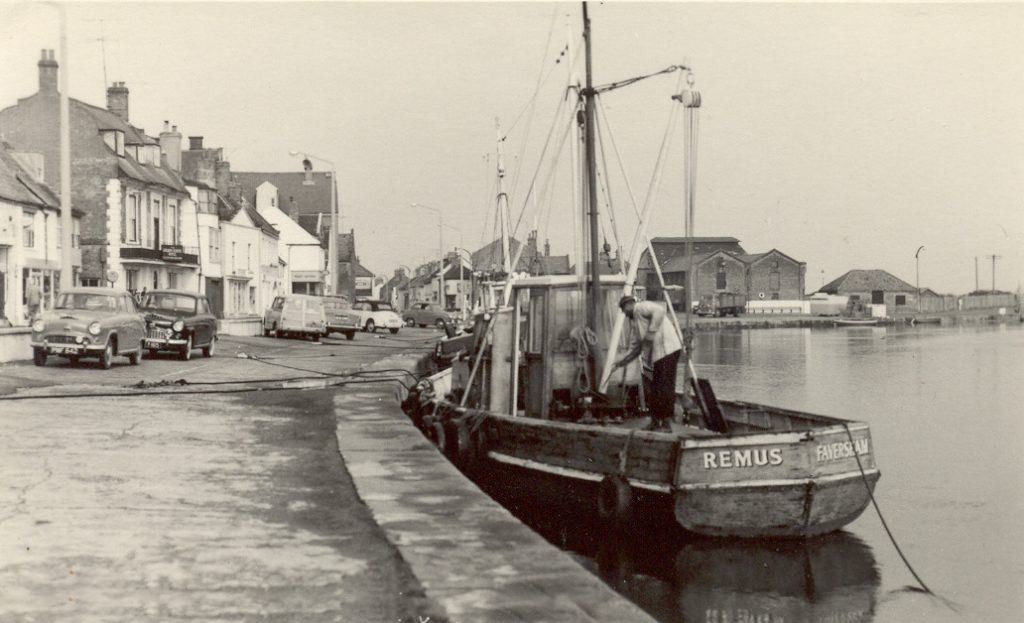
Aircraft War Wrecks being hauled

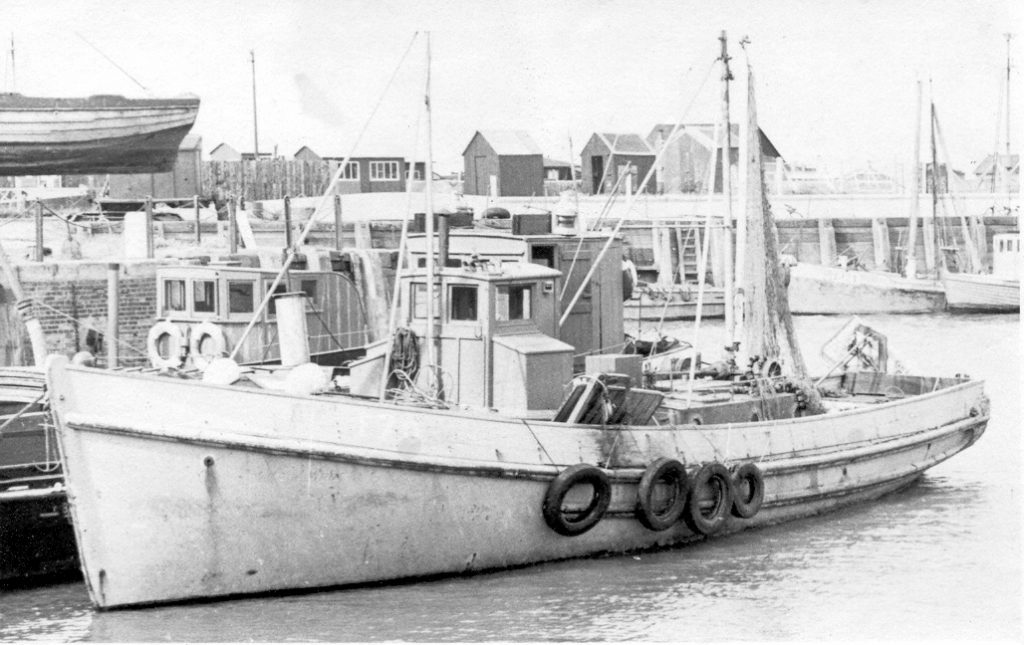
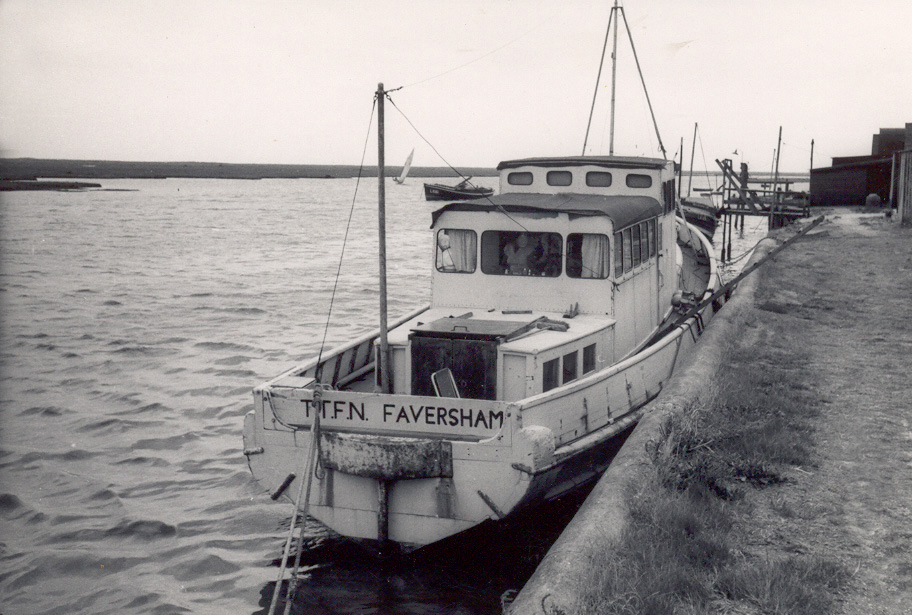
The TTFN was converted as a house boat and taken up to Wells Next to Sea in the late 1950’s where Alf, Joan and their family would live during herring season. This became the family home for 5 years or more. Joan would cook for the fleet and bring up the family. Life was quite a challenge at the time. At the end of the season, Alf and Joan would return to their project in Ickham to restore The Old Rectory. More stories and photos about this period of life can be seen here.
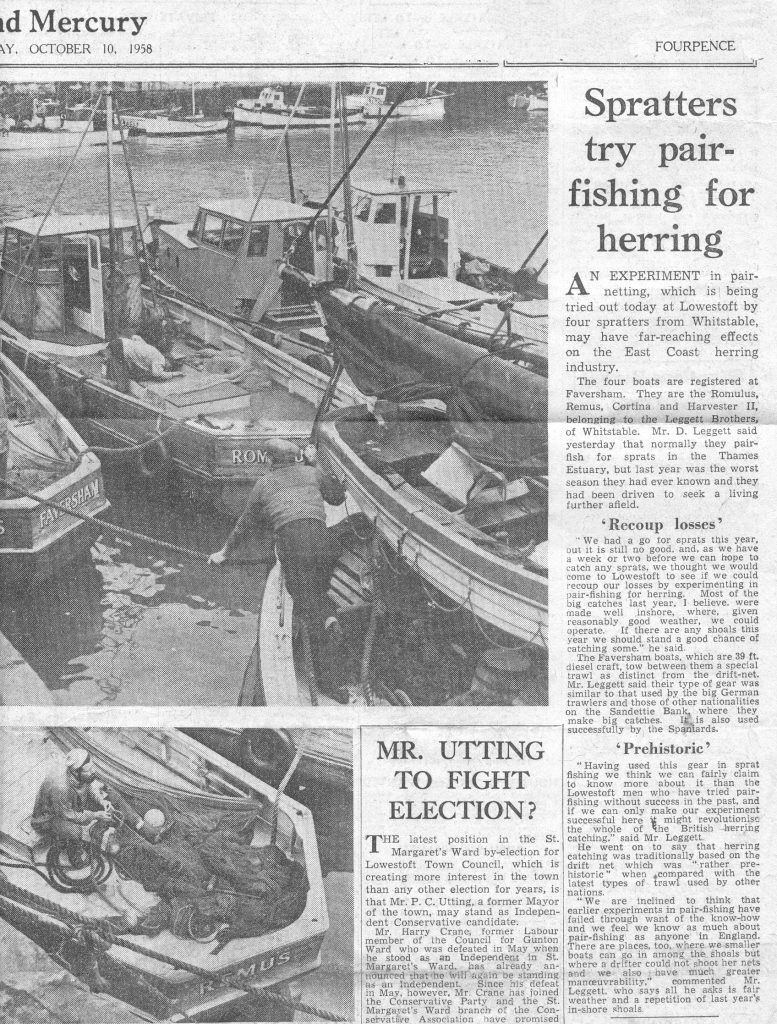
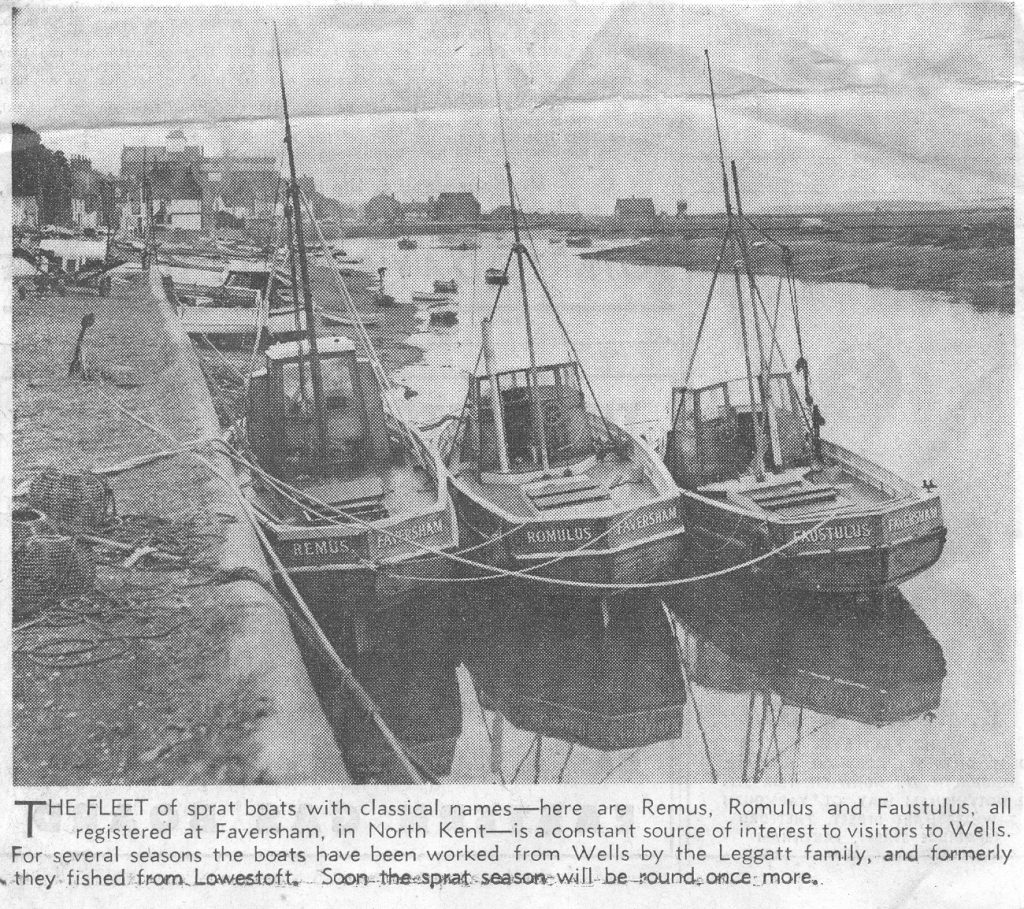
Fishing Life to be continued - Waiting for assistance by John Martin who will help with the record and identify names in photos before they are forgotten.
Click edit button to change this text. Lorem ipsum dolor sit amet, consectetur adipiscing elit. Ut elit tellus, luctus nec ullamcorper mattis, pulvinar dapibus leo. Click edit button to change this text. Lorem ipsum dolor sit amet, consectetur adipiscing elit. Ut elit tellus, luctus nec ullamcorper mattis, pulvinar dapibus leo.Click edit button to change this text. Lorem ipsum dolor sit amet, consectetur adipiscing elit. Ut elit tellus, luctus nec ullamcorper mattis, pulvinar dapibus leo.Click edit button to change this text. Lorem ipsum dolor sit amet, consectetur adipiscing elit. Ut elit tellus, luctus nec ullamcorper mattis, pulvinar dapibus leo.Click edit button to change this text. Lorem ipsum dolor sit amet, consectetur adipiscing elit. Ut elit tellus, luctus nec ullamcorper mattis, pulvinar dapibus leo.
Lorem ipsum dolor sit amet, consectetur adipiscing elit. Ut elit tellus, luctus nec ullamcorper mattis, pulvinar dapibus leo.
Click edit button to change this text. Lorem ipsum dolor sit amet, consectetur adipiscing elit. Ut elit tellus, luctus nec ullamcorper mattis, pulvinar dapibus leo.Click edit button to change this text. Lorem ipsum dolor sit amet, consectetur adipiscing elit. Ut elit tellus, luctus nec ullamcorper mattis, pulvinar dapibus leo.Click edit button to change this text. Lorem ipsum dolor sit amet, consectetur adipiscing elit. Ut elit tellus, luctus nec ullamcorper mattis, pulvinar dapibus leo.Click edit button to change this text. Lorem ipsum dolor sit amet, consectetur adipiscing elit. Ut elit tellus, luctus nec ullamcorper mattis, pulvinar dapibus leo.Click edit button to change this text. Lorem ipsum dolor sit amet, consectetur adipiscing elit. Ut elit tellus, luctus nec ullamcorper mattis, pulvinar dapibus leo.Click edit button to change this text. Lorem ipsum dolor sit amet, consectetur adipiscing elit. Ut elit tellus, luctus nec ullamcorper mattis, pulvinar dapibus leo.Click edit button to change this text. Lorem ipsum dolor sit amet, consectetur adipiscing elit. Ut elit tellus, luctus nec ullamcorper mattis, pulvinar dapibus leo.Click edit button to change this text. Lorem ipsum dolor sit amet, consectetur adipiscing elit. Ut elit tellus, luctus nec ullamcorper mattis, pulvinar dapibus leo.Click edit button to change this text. Lorem ipsum dolor sit amet, consectetur adipiscing elit. Ut elit tellus, luctus nec ullamcorper mattis, pulvinar dapibus leo.Click edit button to change this text. Lorem ipsum dolor sit amet, consectetur adipiscing elit. Ut elit tellus, luctus nec ullamcorper mattis, pulvinar dapibus leo.Click edit button to change this text. Lorem ipsum dolor sit amet, consectetur adipiscing elit. Ut elit tellus, luctus nec ullamcorper mattis, pulvinar dapibus leo.
